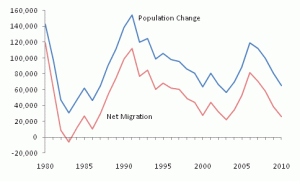MigrationMethod developed for including migration uncertainty in population projections
Statisticians have developed the first model for projecting population that factors in the vagaries of migration, a slippery issue that has bedeviled demographers for decades. Their work also provides population projections for all countries worldwide — and challenges the existing predictions for some, particularly the United States and Germany.

Population changes closely follow net migration changes // Source: wa.gov
Statisticians at the University of Washington have developed the first model for projecting population that factors in the vagaries of migration, a slippery issue that has bedeviled demographers for decades.
Their work, published this week in the Proceedings of the National Academy of Sciences, also provides population projections for all countries worldwide — and challenges the existing predictions for some, particularly the United States and Germany.
“It turns out that for quite a few countries, migration is the single biggest source of uncertainty for population projections,” said principal investigator Adrian Raftery, a UW professor of statistics and sociology.
U Washington notes that for the first time, the researchers used a “probabilistic” model that draws on migration rates in each country and worldwide over the past sixty-five years, along with patterns of fertility and mortality, to project population around the world. The findings were most striking for Germany, whose bureau of statistics has called population decline “inevitable” as the country’s populace ages.
But the UW model predicts that when migration is factored in, Germany’s population decline could be offset by the arrival of more than one million immigrants every five years for most of the next century. The data in the study was collected before the influx of more than 965,000 migrants and refugees into the country in 2015, so the near-term difference could be even more dramatic.
“Our model could change the perception of the future of Germany from a country that goes into decline for the rest of the century to one that may not, if its policy of accepting migrants continues,” said Raftery, also a faculty affiliate for the UW Center for Statistics and the Social Sciences and the UW Center for Studies in Demography and Ecology.
The researchers also predict that France and the United Kingdom are likely to have bigger populations than Germany by 2060, given both countries’ higher fertility rates.
They also predict that the U.S. population has a 10 percent chance of exceeding 610 million over the next eighty-five years — nearly double the current population — when migration is factored in, versus a projected high of 510 million if it is not. While that likelihood is small, it has large ramifications, said lead author Jonathan Azose, a doctoral student in the UW Department of Statistics.
